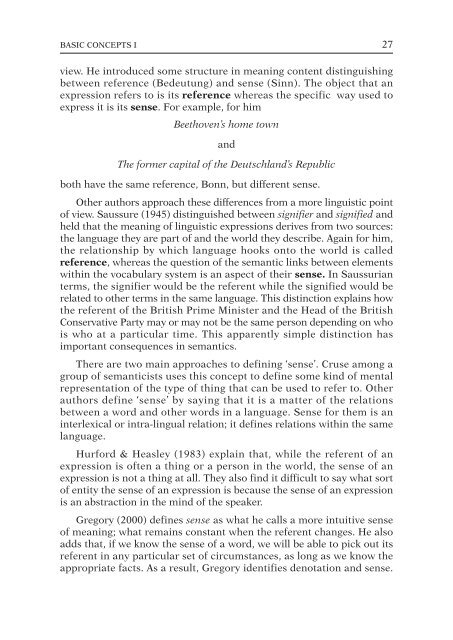Semantics
You also want an ePaper? Increase the reach of your titles
YUMPU automatically turns print PDFs into web optimized ePapers that Google loves.
BASIC CONCEPTS I 27<br />
view. He introduced some structure in meaning content distinguishing<br />
between reference (Bedeutung) and sense (Sinn). The object that an<br />
expression refers to is its reference whereas the specific way used to<br />
express it is its sense. For example, for him<br />
Beethoven’s home town<br />
and<br />
The former capital of the Deutschland’s Republic<br />
both have the same reference, Bonn, but different sense.<br />
Other authors approach these differences from a more linguistic point<br />
of view. Saussure (1945) distinguished between signifier and signified and<br />
held that the meaning of linguistic expressions derives from two sources:<br />
the language they are part of and the world they describe. Again for him,<br />
the relationship by which language hooks onto the world is called<br />
reference, whereas the question of the semantic links between elements<br />
within the vocabulary system is an aspect of their sense. In Saussurian<br />
terms, the signifier would be the referent while the signified would be<br />
related to other terms in the same language. This distinction explains how<br />
the referent of the British Prime Minister and the Head of the British<br />
Conservative Party may or may not be the same person depending on who<br />
is who at a particular time. This apparently simple distinction has<br />
important consequences in semantics.<br />
There are two main approaches to defining ‘sense’. Cruse among a<br />
group of semanticists uses this concept to define some kind of mental<br />
representation of the type of thing that can be used to refer to. Other<br />
authors define ‘sense’ by saying that it is a matter of the relations<br />
between a word and other words in a language. Sense for them is an<br />
interlexical or intra-lingual relation; it defines relations within the same<br />
language.<br />
Hurford & Heasley (1983) explain that, while the referent of an<br />
expression is often a thing or a person in the world, the sense of an<br />
expression is not a thing at all. They also find it difficult to say what sort<br />
of entity the sense of an expression is because the sense of an expression<br />
is an abstraction in the mind of the speaker.<br />
Gregory (2000) defines sense as what he calls a more intuitive sense<br />
of meaning; what remains constant when the referent changes. He also<br />
adds that, if we know the sense of a word, we will be able to pick out its<br />
referent in any particular set of circumstances, as long as we know the<br />
appropriate facts. As a result, Gregory identifies denotation and sense.



